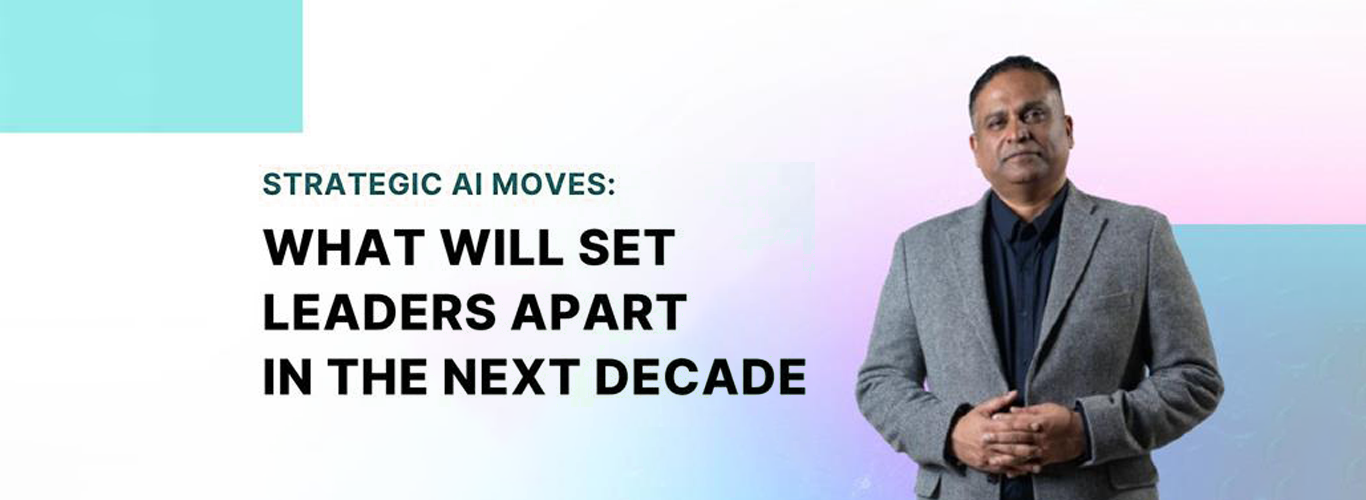Strategic AI Moves: What Will Set Leaders Apart in the Next Decade
A couple of years ago, we watched Unilever implement an AI-powered demand-sensing system that slashed their forecast error by double digits. It didn’t make headlines in the way ChatGPT does, but it did something more important for businesses: it increased their ROI.
That kind of move, the deliberate, enterprise-wide, rooted in business logic, is the kind of strategic intelligence we’re going to need more of in the coming decade.
I’ve seen this story before, just with different labels. We moved from digitization to datafication, then to cloud-first. And now, we’re at the most promising, and riskiest, inflection point yet: the shift from conventional AI to Agentic AI.
If you’re a leader today, it’s not about whether you use AI. It’s whether your strategy moves with intelligence, or just performs with directions.
Most AI Strategies Are Just Motion Without Movement
We listen to a lot of boardroom chats recently where the AI update sounds like this:
“We’ve got a chatbot POC, three GenAI pilots, and we’re experimenting with LLM.”
Great. But where’s the movement?
What I see across industries is a flurry of AI activity, with very little enterprise transformation to show for it. Teams are automating minor workflows, running isolated pilots, or integrating AI into already outdated systems. It’s like trying to retrofit a racecar engine onto a tricycle.
This is the first pitfall: mistaking activity for strategy. Without architectural thinking, AI just becomes noise, disconnected, unscalable, and ultimately forgettable.
The Four Strategic Moves Transforming Enterprises
So what does real strategic movement look like? Over the past 18 months, the most transformative enterprises are making four high-leverage moves:
- From Data Access to Decision Intelligence
We’ve been obsessed with dashboards for too long. But leaders are realizing: data isn’t the bottleneck, decisions are.
The next frontier is systems that translate real-time data into contextual, intelligent actions. Not just alerts, but prioritization.
Think of it as replacing a weather report with an AI that says:
“Storm incoming. Here’s what you need to do right now, and why.”
The real value of data is how fast and how intelligently it translates into action.
- The Operational Intelligence
Automation has been useful, but it’s mostly been about following steps faster. The game now is to build operations that sense, adapt, escalate, and act autonomously.
Our platform, OpsIQ, enables workflows to operate with context, memory, and decision loops, not just rules.
We call this Agentic autonomy.
- From Systems That Learn → Organizations That Learn
The most competitive AI systems aren’t just accurate. They’re curious. They learn continuously from human interaction, environment feedback, and real-world signals.
We’ve built our platforms, like Agent Factory, to loop in reinforcement, learning, and iteration. But it’s not enough for the systems to learn. The organization must learn alongside.
Because speed isn’t the differentiator anymore. Adaptability is.
- From Tool Skills to Digital Grit
Here’s a hard truth: You can’t outsource AI understanding.
Too many enterprises are investing in prompt engineers while their business units remain AI-illiterate.
The strategic edge comes from building digital grit: AI-fluent product managers, adaptive business architects, and cross-functional teams that can shape AI with a purpose, not just use it with curiosity.
AI is not a tool problem. It’s a talent transformation challenge.
Where Most Leaders Get Distracted
What derails strategic AI? The distractions are predictable:
- Investing in hype tools before use-case alignment
- Launching pilots that never move beyond innovation silos
- Choosing platforms without a view of long-term business architecture
These feel like progress. But they’re often a form of strategic procrastination.
The truth is, transformation doesn’t start with tech. It starts with clarity.
What an AI-Native Enterprise Really Looks Like
It’s easy to say “AI-first.” But what does that actually look like?
In AI-native enterprises, intelligence is not centralized in a CoE. It’s embedded into every function, process, and interaction.
You’ll notice a few patterns:
- Decision-making is distributed, not bottled up at the top
- Human-AI teams are intentionally designed, not accidentally formed
- Customer, operations, and product layers are connected through a continuous flow of intelligence
Building It Right: Why an AI Roadmap Matters
You don’t get to this state by patching together pilots. You get there by thinking architecturally.
That’s why we created Nuvento’s AI Roadmap, not just as consulting, but as a transformation enabler.
Here’s what it does:
- Identifies strategic leverage points
- Avoids pilot fatigue by linking initiatives to real business KPIs
- Builds the scaffolding for agentic, autonomous systems
“You don’t need a hundred AI projects.
You need a roadmap that turns intelligence into advantage.”
The Nuvento Journey: Inside-Out Transformation
Let me be transparent, we’ve all lived through the AI chaos ourselves.
In our early days, We tried to automate before understanding. Sound familiar?
It wasn’t until we asked a different question, “What decisions are we trying to make smarter?”, that everything clicked.
From that lens, we restructured our platforms:
- Agent Factory became about designing autonomous workflows
- CASIE emerged as our digital brain for conversational assistance
- OpsIQ matured into a livewire for agentic operations
The Real Risk Isn’t Doing Too Much, It’s Doing Too Little, Too Safely
Let me leave you with this:
The greatest threat to AI transformation isn’t overspending. It’s undercommitting.
Playing it safe with AI is the riskiest move of all, because your competitors aren’t waiting.
AI isn’t an IT investment. It’s a platform shift for how your business learns, decides, and grows.
If you’re serious about future-proofing your enterprise, don’t start with tools. Start with clarity. Start with a roadmap.
Let’s build it together.
Ready to build your enterprise AI roadmap?
Let’s talk.






